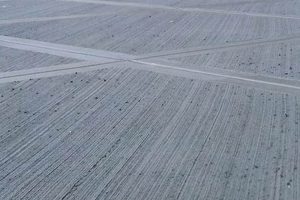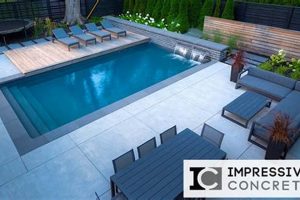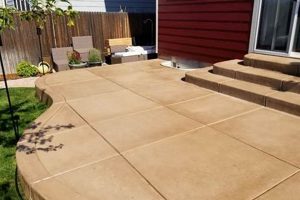Treatments applied to concrete surfaces within buildings to enhance aesthetics, durability, and functionality are critical design elements. Examples include polished concrete floors that offer a sleek, modern appearance and microcement walls providing a seamless, minimalist style. These applications transform a raw construction material into a refined interior element.
These applications offer a versatile solution for both residential and commercial spaces, valued for their longevity, ease of maintenance, and design flexibility. Historically, concrete was primarily a structural component, but its potential as a decorative surface has led to widespread adoption, fostering creative expression in interior design. Benefits include increased energy efficiency through thermal mass, resistance to wear and tear, and the ability to achieve a variety of textures and colors.
The subsequent sections will explore the different types of treatments available, application techniques, maintenance requirements, and cost considerations. Furthermore, design trends utilizing these materials will be highlighted, providing a comprehensive overview of their role in contemporary interior design.
Enhancing Interior Spaces
Achieving optimal results requires careful planning and execution. The following points offer essential guidance for specifiers and installers.
Tip 1: Surface Preparation is Paramount: Proper preparation is crucial for adhesion and longevity. The substrate must be clean, free of contaminants, and properly profiled. This often involves grinding, shot-blasting, or acid etching to achieve the required surface texture.
Tip 2: Moisture Mitigation is Essential: Concrete’s porosity means moisture can compromise the integrity of applied treatments. Moisture testing is non-negotiable, and appropriate vapor barriers or moisture mitigation systems should be implemented to prevent blistering, delamination, and efflorescence.
Tip 3: Select the Appropriate Treatment: Different types offer varying degrees of durability, aesthetic appeal, and maintenance requirements. Polished concrete provides a durable, low-maintenance surface, while microcement offers a seamless, decorative overlay. Careful consideration of the intended use and desired aesthetic is essential.
Tip 4: Consider Color and Texture: The color and texture significantly impact the overall aesthetic. Integral color pigments can be added to the concrete mix, while stains and dyes can be applied to the surface. Textures can be achieved through various finishing techniques, such as troweling, stamping, or acid etching.
Tip 5: Sealing and Protection: A high-quality sealer protects against staining, abrasion, and chemical attack. The choice of sealer depends on the type of treatment and the level of traffic expected. Regular resealing may be necessary to maintain optimal performance.
Tip 6: Control Joints are Necessary: Properly installed control joints minimize cracking due to shrinkage and thermal expansion. The layout and depth of control joints should be carefully planned during the design phase.
Tip 7: Consider Lighting: Lighting significantly impacts the visual appearance. Natural and artificial light can accentuate the texture, color, and reflective properties. Strategic lighting placement can enhance the aesthetic appeal and create the desired ambiance.
By adhering to these guidelines, professionals can ensure the successful implementation, maximizing its aesthetic and functional benefits.
The subsequent sections will delve into specific techniques and applications, providing further insights into realizing the full potential within interior spaces.
1. Durability
Durability is a paramount consideration when selecting treatments for interior concrete. The inherent strength of concrete, combined with appropriate finishing techniques, results in surfaces resistant to wear, abrasion, and impact. This resistance directly impacts the longevity of the installation, reducing the need for frequent repairs or replacements. For example, polished concrete floors in high-traffic retail environments demonstrate exceptional durability, withstanding constant foot traffic and the movement of equipment without significant degradation. The choice of sealer also contributes; epoxy-based sealers provide greater abrasion resistance than acrylic sealers, influencing the overall lifespan. Understanding these material properties and their interaction is crucial for specifiers aiming to achieve a durable and cost-effective interior surface.
The structural integrity of the concrete substrate significantly influences the durability of the applied treatments. Cracks, voids, or uneven surfaces can compromise the finish, leading to premature failure. Proper surface preparation, including patching and leveling, is essential to ensure a uniform and structurally sound base. Furthermore, the presence of moisture within the concrete can negatively affect the adhesion of coatings and overlays. Addressing moisture issues prior to application is critical to prevent blistering, delamination, and other forms of deterioration. Consider the case of a warehouse floor; if the floor has not been appropriately treated and protected, forklift, wear and tear and spills of chemicals can damage the floor. The long-term wear and tear of this can be costly and problematic.
In summary, durability in interior concrete is achieved through a combination of material selection, application technique, and environmental control. Specifying appropriate treatments based on anticipated traffic and usage, combined with rigorous surface preparation and moisture mitigation strategies, is crucial for maximizing the lifespan and minimizing maintenance requirements. While initial costs may be higher for more durable options, the long-term benefits in terms of reduced repairs and replacements often outweigh the initial investment. The practical implication of prioritizing durability is a reduction in lifecycle costs and environmental impact, aligning with sustainable building practices.
2. Aesthetics
Aesthetics represent a core driver in the specification of interior concrete treatments. The inherent visual versatility of concrete allows for a broad spectrum of design possibilities, ranging from industrial minimalism to refined elegance. The selection of specific finishing techniques, such as polishing, staining, or microcement application, directly influences the resulting aesthetic outcome. For example, polished concrete offers a sleek, reflective surface that enhances natural light and creates a sense of spaciousness, commonly employed in modern lofts and retail spaces. In contrast, acid-stained concrete provides a mottled, variegated appearance, suitable for rustic or vintage-inspired designs, often seen in restaurants and cafes. Thus, the aesthetic considerations directly determine the type of application selected, reflecting a cause-and-effect relationship.
The importance of aesthetics extends beyond mere visual appeal. The chosen finish can influence the perceived value and character of a space, impacting occupant experience and brand identity. A well-executed treatment elevates the overall design, creating a cohesive and inviting atmosphere. For instance, a corporate office employing a seamless microcement wall finish projects a modern and sophisticated image, contributing to a positive impression on clients and employees. The ability to customize color, texture, and pattern allows designers to tailor the finish to specific design objectives, ensuring a harmonious integration with the overall interior scheme. Practical applications involve considering factors like light reflectance, slip resistance, and visual contrast to create a functional and aesthetically pleasing environment.
In summary, aesthetics are an indispensable component of these finishing treatments. They enable designers to transform a utilitarian material into a visually compelling element, influencing the mood, atmosphere, and perceived value of a space. Challenges include balancing aesthetic desires with practical considerations such as durability, maintenance, and cost. Ultimately, a successful integration of aesthetics within these finishing treatments contributes to a holistic design that enhances both the functionality and visual appeal of interior environments. This integration reflects a growing recognition of the role of design in creating spaces that are not only functional but also inspiring and engaging.
3. Functionality
Functionality is a core consideration in the application of interior concrete finishes, dictating the suitability of a given treatment for its intended purpose. It extends beyond mere aesthetics, encompassing performance characteristics that impact usability, safety, and long-term maintenance.
- Slip Resistance
Slip resistance is paramount in areas prone to moisture or spills, such as kitchens, bathrooms, and entryways. Polished concrete, while visually appealing, can become slippery when wet unless treated with anti-slip additives or coatings. Texturing the surface during installation or applying specialized sealers improves traction and minimizes the risk of falls. This is crucial for ensuring compliance with safety regulations and preventing accidents.
- Cleanability and Maintenance
The ease with which a surface can be cleaned and maintained directly impacts its long-term usability. Concrete finishes vary significantly in their porosity and susceptibility to staining. Sealed concrete, for example, offers a protective barrier against liquids and dirt, simplifying routine cleaning. Unsealed or porous surfaces, conversely, require more frequent and rigorous cleaning to prevent staining and bacterial growth. The choice of finish should align with the expected level of traffic and the potential for spills or contamination.
- Acoustic Properties
Concrete, by nature, is a dense and sound-reflective material. In large, open spaces, this can lead to excessive reverberation and noise levels, impacting speech intelligibility and overall comfort. Mitigating these acoustic issues often involves incorporating sound-absorbing materials, such as rugs, textiles, or acoustic panels, in conjunction with concrete flooring. Alternatively, specialized concrete treatments, such as textured or porous finishes, can help to diffuse sound and reduce echo.
- Thermal Performance
Concrete possesses significant thermal mass, meaning it can absorb and store heat. This property can be advantageous in passively heated or cooled buildings, moderating temperature fluctuations and reducing energy consumption. However, in climates with extreme temperature variations, uninsulated concrete floors can feel cold to the touch and contribute to heat loss. Incorporating underfloor heating systems or using insulating underlays can improve thermal comfort and energy efficiency.
These functional attributes underscore the importance of a holistic approach to specification. Considering slip resistance, cleanability, acoustic properties, and thermal performance alongside aesthetic preferences ensures that the chosen treatment not only looks appealing but also contributes to a safe, comfortable, and sustainable interior environment. Failure to address these functional requirements can compromise the usability and longevity of the installation, leading to costly rework or dissatisfaction among occupants.
4. Sustainability
The integration of sustainable practices within the realm of interior concrete is increasingly significant, driven by both environmental concerns and evolving building standards. Concrete, traditionally associated with high carbon emissions, can be transformed into an environmentally responsible material through strategic choices in material sourcing, production methods, and application techniques. Understanding these sustainable facets is crucial for informed decision-making and achieving environmentally conscious interior design.
- Recycled Content and Material Sourcing
Utilizing recycled aggregates, such as crushed glass, demolition debris, or industrial byproducts, reduces the demand for virgin resources and diverts waste from landfills. Specifying concrete mixes with high percentages of supplementary cementitious materials (SCMs), such as fly ash or slag, further lowers the carbon footprint by partially replacing Portland cement, the most energy-intensive component. Locally sourced materials minimize transportation distances, reducing fuel consumption and associated emissions. The use of sustainable aggregates not only provides a responsible alternative but also can introduce unique textures and aesthetics.
- Reduced Embodied Carbon
Concrete production is a significant source of carbon dioxide emissions. Selecting concrete mixes with lower embodied carbon, achieved through optimized mix designs, the use of alternative cementitious materials, and carbon capture technologies, minimizes the environmental impact. Life Cycle Assessments (LCAs) provide a comprehensive evaluation of the environmental burdens associated with different concrete options, enabling informed material selection. Innovations in cement manufacturing, such as carbon-negative aggregates and alternative clinker production processes, are further reducing the embodied carbon of concrete.
- Durability and Longevity
The durability of the chosen concrete finish directly correlates with its sustainability. Durable finishes require less frequent replacement, minimizing resource consumption and waste generation over the building’s lifespan. Polished concrete, known for its exceptional longevity and resistance to wear, offers a sustainable flooring solution compared to materials that require periodic replacement. Proper maintenance and sealing further extend the lifespan, reducing the environmental burden associated with repair or replacement cycles. Selecting durable finishes minimizes the long-term environmental impact.
- Thermal Mass and Energy Efficiency
Concrete’s high thermal mass allows it to absorb and store heat, moderating temperature fluctuations within buildings and reducing energy consumption for heating and cooling. Exposing interior concrete elements, such as floors or walls, maximizes their thermal mass potential. In climates with significant temperature swings, this can lead to substantial energy savings and a reduced reliance on mechanical heating and cooling systems. Combining thermal mass with passive solar design principles further enhances energy efficiency.
These sustainable facets collectively contribute to a more environmentally responsible approach to interior design. By prioritizing recycled content, reducing embodied carbon, selecting durable finishes, and leveraging concrete’s thermal mass, designers and specifiers can minimize the environmental footprint of interior concrete. The integration of these practices aligns with broader sustainability goals, promoting resource conservation, waste reduction, and energy efficiency within the built environment.
5. Maintenance
Maintenance is an intrinsic factor influencing the long-term performance and aesthetic appeal of interior concrete finishes. The type of finish selected directly dictates the required maintenance regime, impacting lifecycle costs and the sustained visual quality of the treated surface. Polished concrete, for instance, typically requires minimal maintenance, consisting primarily of routine sweeping and occasional damp mopping. Conversely, surfaces treated with penetrating sealers or topical coatings may necessitate periodic reapplication to maintain their protective qualities and aesthetic appearance. This fundamental cause-and-effect relationship underscores the importance of considering maintenance requirements during the initial specification phase.
The significance of maintenance is amplified in high-traffic areas, such as retail spaces or commercial lobbies, where surfaces are subjected to increased wear and tear. Failure to implement an appropriate maintenance schedule can result in premature deterioration, staining, and loss of luster, diminishing the overall aesthetic and potentially necessitating costly repairs or replacements. Consider the example of a restaurant floor finished with a decorative stain and sealer. If spills are not promptly cleaned, or if the sealer is not periodically reapplied, the surface may become permanently stained and abraded, requiring extensive restoration. Therefore, a proactive maintenance approach is essential for preserving the integrity and appearance of concrete surfaces in demanding environments.
In summary, effective maintenance is paramount to maximizing the lifespan and preserving the aesthetic qualities of interior concrete. Understanding the specific maintenance requirements associated with different finish types allows for informed decision-making during the design and specification process. Implementing a well-defined maintenance schedule, tailored to the environment and usage patterns, ensures long-term performance and minimizes the need for costly repairs or replacements. The practical implication of this understanding is a reduction in lifecycle costs and a sustained visual quality that enhances the overall interior environment.
Frequently Asked Questions
The following section addresses common inquiries regarding treatments for interior concrete, providing clarity on their properties, applications, and maintenance.
Question 1: What is the typical lifespan of interior concrete?
Lifespan varies significantly depending on the chosen treatment, usage, and maintenance. Properly installed and maintained polished floors can last for decades, while stained or coated surfaces may require periodic reapplication to maintain their appearance and protective qualities. Factors such as foot traffic, exposure to chemicals, and the quality of the initial installation directly influence longevity.
Question 2: Are interior concrete floors cold and uncomfortable?
Concrete, inherently a thermally conductive material, can feel cool to the touch, particularly in colder climates. However, this can be mitigated through the installation of radiant heating systems or the use of area rugs to provide thermal insulation. The thermal mass of concrete can also be an advantage, helping to regulate indoor temperatures and reduce energy consumption.
Question 3: Is interior concrete a sustainable building material?
Sustainability depends on various factors, including material sourcing, production methods, and the incorporation of recycled content. Utilizing recycled aggregates, reducing cement content through the use of supplementary cementitious materials, and minimizing transportation distances can significantly improve the environmental profile. Additionally, the durability and longevity of concrete reduce the need for frequent replacements, minimizing resource consumption.
Question 4: What are the primary maintenance requirements for interior concrete?
Maintenance requirements vary depending on the chosen treatment. Polished concrete typically requires routine sweeping and occasional damp mopping. Stained or coated surfaces may necessitate periodic resealing to maintain their protective qualities and aesthetic appearance. Promptly addressing spills and using appropriate cleaning products are essential for preventing staining and damage.
Question 5: Can interior concrete be used in kitchens and bathrooms?
Concrete is suitable for use in kitchens and bathrooms, provided appropriate sealers are applied to protect against moisture penetration and staining. Epoxy-based sealers offer superior water resistance compared to acrylic sealers. Slip resistance is also a critical consideration in these areas, requiring textured finishes or anti-slip additives to ensure safety.
Question 6: What are the cost considerations associated with interior concrete?
The initial cost varies depending on the complexity of the design, the type of treatment chosen, and the labor required for installation. While initial costs may be higher than some other flooring options, the durability and longevity of concrete can result in lower lifecycle costs due to reduced maintenance and replacement needs. Obtaining multiple quotes from experienced contractors is recommended to ensure competitive pricing.
In summary, these treatments offer a versatile and durable option for interior spaces, provided that careful consideration is given to material selection, installation techniques, and maintenance requirements. Addressing these factors ensures long-term performance and aesthetic satisfaction.
The subsequent section will delve into case studies and examples of successful applications, providing real-world illustrations of their use in diverse interior environments.
Conclusion
This exploration of interior concrete finishes has illuminated their versatility, durability, and aesthetic potential. From understanding surface preparation to recognizing the importance of sustainable material choices, the preceding analysis underscores the complexities involved in achieving optimal results. Key considerations, including maintenance requirements and functionality, dictate the suitability of various treatments for diverse interior spaces. Proper planning and execution are paramount for realizing the full benefits.
The future of interior design will likely witness an increasing adoption of concrete treatments, driven by a growing emphasis on sustainability and a desire for durable, aesthetically pleasing surfaces. A continued focus on innovation in material science and application techniques will further enhance the capabilities and broaden the appeal of these finishes. It remains critical for designers, architects, and contractors to remain informed about evolving best practices to ensure successful and long-lasting installations.


![Concrete Finishes: Types, Cost, Application [Guide] Best Final Touch: Elevate Your Projects with Professional Finishing Concrete Finishes: Types, Cost, Application [Guide] | Best Final Touch: Elevate Your Projects with Professional Finishing](https://bestfinaltouch.com/wp-content/uploads/2025/12/th-566-300x200.jpg)




